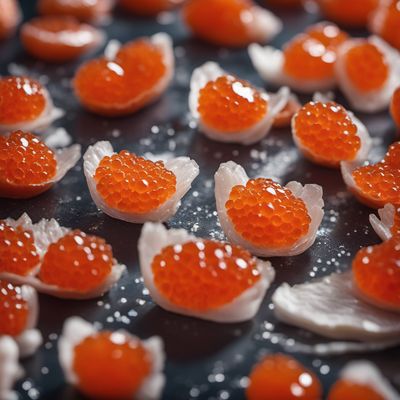
Ingredient
Mackerel roe
The Ocean's Golden Treasure: Exploring the Delicacy of Mackerel Roe
Mackerel roe is the egg sac of the mackerel fish, typically found in the ovaries of female mackerel. It has a soft, creamy texture and ranges in color from pale yellow to deep orange. The roe is encased in a thin membrane and is often enjoyed for its rich, briny flavor that is reminiscent of the sea. When cooked, mackerel roe becomes slightly firm and develops a buttery, melt-in-your-mouth consistency. Its appearance adds a touch of elegance to any dish, with its vibrant color and glossy surface.
Origins and history
Mackerel roe has a long history in various cuisines around the world. It has been consumed for centuries in countries like Japan, Korea, and Scandinavia, where it is considered a delicacy. In Japan, mackerel roe, known as "sujiko," is often marinated and served as a topping for sushi or enjoyed as a standalone dish. In Scandinavian cuisine, it is commonly smoked and served alongside bread or potatoes. The use of mackerel roe in these cultures reflects the abundance of mackerel in their coastal waters and the appreciation for its unique flavor and texture.
Nutritional information
Mackerel roe is a nutrient-dense ingredient, rich in omega-3 fatty acids, protein, and essential vitamins and minerals. It provides a good source of vitamin B12, selenium, and phosphorus. A 100-gram serving of mackerel roe contains approximately 200 calories.
Allergens
Mackerel roe may pose a risk for individuals with seafood allergies. It is important to exercise caution and consult with a healthcare professional if you have any known allergies.
How to select
When selecting mackerel roe, look for firm, intact sacs with a vibrant color. Avoid roe that appears discolored, mushy, or has a strong fishy odor. Fresh mackerel roe should have a slightly sweet aroma and a glossy appearance.
Storage recommendations
To maintain the freshness and quality of mackerel roe, it is recommended to store it in the refrigerator at a temperature between 32°F and 39°F (0°C and 4°C). Keep it in its original packaging or wrap it tightly in plastic wrap to prevent exposure to air. Consume it within a few days of purchase for the best flavor and texture.
How to produce
Mackerel roe is typically harvested from mature female mackerel during their spawning season. It requires specialized knowledge and equipment to extract the roe without damaging it. As such, it is best left to professional fishermen and fish processors.
Preparation tips
Mackerel roe can be enjoyed in various ways. It can be lightly salted and marinated to enhance its flavor, then served as a topping for sushi or sashimi. It can also be pan-fried or grilled to develop a crispy exterior while maintaining its creamy interior. Mackerel roe pairs well with citrus flavors, fresh herbs, and creamy sauces. When cooking, be gentle to preserve its delicate texture.
Culinary uses
Mackerel roe is commonly used in Japanese cuisine, where it is enjoyed as a sushi topping, served alongside rice, or incorporated into various seafood dishes. It can also be used as a filling for sushi rolls or added to pasta dishes for a unique twist. In Scandinavian cuisine, smoked mackerel roe is often served as an appetizer or used as a garnish for open-faced sandwiches.
Availability
Mackerel roe is commonly available in coastal regions where mackerel fishing is prevalent. It can be found in countries such as Japan, Korea, Scandinavia, and other regions with a strong seafood culture.
More ingredients from this category

Dolphinfish roe
Oceanic Delicacy: Dolphinfish Roe

Cod roe
"The Ocean's Delicacy: Exploring the Richness of Cod Roe"

Shad roe
Delicate Delicacy

Mullet roe
The Delicacy of the Sea

Salmon roe, atlantic
"Oceanic Delicacy: Exploring the World of Atlantic Salmon Roe"

Herring roe
"Oceanic Delicacy: Exploring the World of Herring Roe"

Bluefish roe
Oceanic Delicacy: Exploring Bluefish Roe

Sturgeon roe
The Jewel of the Sea

Lumpfish roe
The Jewel of the Sea

Flounder roe
The Ocean's Golden Treasure: Exploring the Delicacy of Flounder Roe

Salmon roe, pacific
Oceanic Delicacy


